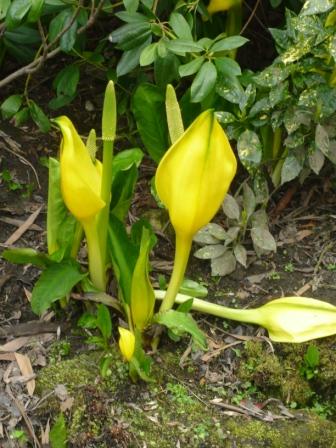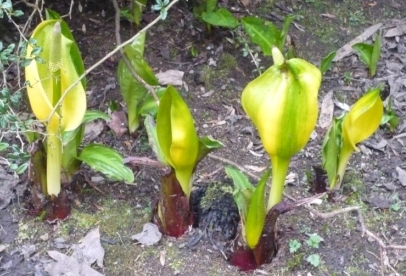Skunk Cabbage Kicks up a New Stink
Latest news on Skunk Cabbage
Repeated below is our post from 2009 when I first reported on the water loving skunk cabbage. In 2021 the RHS have decided that the proliferation of this plant is endangering native species and they should not be grown in the UK. The RHS say ‘after flowering seed heads should be cut off and burnt’ this should help the spread of the rouge amongst our aquatic plants in areas such as the Wye Valley and Lake District.
If you followed our tip to grow this plant I leave it to you what you may wish to do. I am not changing my mind as it is not yet a plant on the banned list under Schedule 9 of The Wildlife and Countryside Act
‘American Skunk Cabbage Lysichiton americanus is planted in groups along the streamside at the Valley Garden Harrogate. Over the years the plants have seeded themselves freely and now make a fantastic display covering the full length of the stream and beyond. The yellow flame-shaped flowers really called spathes, are 18 inches high and look magnificent reflected in the water in April and May. Then the flowers are followed by enormous paddle-shaped, leathery green leaves which remain until dieing back in autumn.
Lysichiton camschatcensis has a hypnotic white spathe and lime green flowering head and a cross between the two species produces a cream spathe (I like to call a spathe a spathe). This spathe surrounds a cigar shaped stem called the spadix which bears many small, bisexual green flowers.
The name Skunk Cabbage is a reference to the strong scent the flowers emit to attract pollinating insects early in the season. Lysichiton americanus shown above has an RHS AGM.
Cultivation of Skunk Cabbage
- Skunk cabbages grow best in deep soil rich in humus that has plenty of moisture. That makes them ideal plants for bog gardens, marginal plants and stream sides and will make sizeable clumps.
- Skunk Cabbage are rhizomatous herbaceous perennials and can be carefully divided.
- Plants are generally disease and predator resistant so are easy to maintain.
- Ripe seeds sown in good seed compost should be kept saturated by standing in water and the resulting plants will take up to 6 years to flower.
- Skunk Cabbage flowers in sun or partial shade but dislikes full shade.
Uses of Skunk Cabbage
- The Iroquois native Americans used the boiled leaves as ‘famine food’ but that is not recommended as the plants contain Oxalate crystals which burn the lips and throat.
- It may be a bit grizzly but Bears coming out of hibernation eat the Skunk Cabbage as a laxative.
- The leaves have been used to wrap food for cooking or as baskets for foraging.
- In some medical botany reports the Skunk cabbage was also used as a diuretic or for children with worms.’

